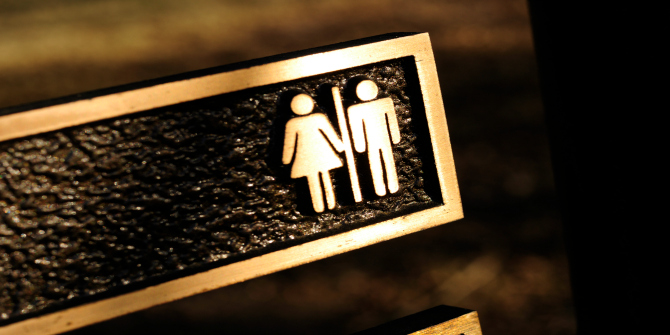In Who’s Afraid of Gender?, Judith Butler confronts contemporary attacks on gender from right-wing movements that have undermined the rights of women, queer and trans people in areas from reproductive justice to protections against violence. The book deftly unpacks the phantasm of gender as it has been weaponised against queer and trans people and argues for countering it not with commensurate hate, but by making more desirable a way of living based in freedom and empathy, writes Elaine Coburn.
Judith Butler came to LSE to launch the book in March 2024: watch it back on YouTube.
Who’s Afraid of Gender? Judith Butler. Allen Lane. 2024.
 This book is a ghost story. It is about phantasms conjured up by actors that include the Pope and the novelist JK Rowling. The ghost is sometimes “gender”, sometimes “gender ideology” and sometimes “Judith Butler.” This expansive, often contradictory phantasm is a repository for displaced fears of war, economic inequality, climate change and associated threats to existence.
This book is a ghost story. It is about phantasms conjured up by actors that include the Pope and the novelist JK Rowling. The ghost is sometimes “gender”, sometimes “gender ideology” and sometimes “Judith Butler.” This expansive, often contradictory phantasm is a repository for displaced fears of war, economic inequality, climate change and associated threats to existence.
Not to be confused with their phantasmagorical other, the flesh and blood philosopher Judith Butler seeks to exorcise the ghost. They do this by mobilising logic, argument and a deep care for the self and others. Amid rising fascisms and authoritarianisms, Butler maintains that what is at stake is the right to a “livable life” (264). When reasonable, justified fears of destruction are displaced onto “gender”, they warn, queer and trans people, as well as intellectuals like Butler, become targets.
Amid rising fascisms and authoritarianisms, Butler maintains that what is at stake is the right to a ‘livable life’.
Opponents are powerful figures. In 2015, Pope Francis condemned “gender theory”, because, he argued, it does not recognise the existence of men and women and therefore “does not recognize the order of creation” (6). Gender theory is contrary to natural law, as given by the Creator (79). The Pope then asserts that “Family is family!” (77), but he means only one kind of family: the heterosexual household, united in marriage. All other forms of love and kinship are disqualified.
As Butler observes, this is confused. Theories about sex and gender, including Butler’s own approach, do not argue that it is impossible to recognise sex and gender. Instead, the argument is that because sex and gender are socially constructed in different ways, in different times and places, they are mutable. Sex is variously defined: genetically, hormonally, and physically. It is not an unchanging, universal given, whether within contemporary medicine or socially and culturally.
Theories about sex and gender, including Butler’s own approach, do not argue that it is impossible to recognise sex and gender. Instead, the argument is that because sex and gender are socially constructed in different ways, in different times and places, they are mutable.
Likewise, despite colonialism, Butler observes, many genders have existed and persist today across different cultures, beyond the woman/man binary of Western modernity. The hijra in India are just one well-known example and, Butler observes, there are many languages where gender binaries are not systematically inscribed in descriptions of the human. In answer to the question, “What is my gender?”, queer theorists thus argue that there are possibilities beyond the binary statements, “I am a man,” or “I am a woman”.
The same is true for heterosexual marriages and families. Heterosexual married households exist, for some, as both a social fact and as a valued choice. They are but one reality and one possibility, however, amid more expansive understandings of kinship. The recognition of a plurality of genders and families, both in fact and as liberatory possibility, is a major contribution of gender and queer theory, as inspired by the feminist and LGBTQ+ movements that supported these intellectual developments.
Heterosexual married households exist, for some, as both a social fact and as a valued choice. They are but one reality and one possibility, however, amid more expansive understandings of kinship.
If the Pope is haunted by the ghost of “gender theory”, as the Catholic Church has resurrected it – not necessarily accurately – he has some unlikely allies. In June 2020, Rowling infamously wrote a series of texts on the social media platform X (then “Twitter”). Among her observations, she expressed empathy and solidarity with trans women. In particular, Rowling emphasised the need to support trans women against threats of male violence. “[T]he majority of trans-identified people not only pose zero threat to others,” Rowling wrote, “but are vulnerable…” (163). Such solidarity, Butler observes, unites cisgender and trans women.
Unfortunately, Butler adds, in focusing on threats posed by individual men, Rowling fails to critique patriarchal social orders that produce and sanction masculine violence. Worse, Rowling then suggests that “natal girls and women” (164) must be protected from trans women – whom she abruptly redescribes as men – in a context where men are habitually violent towards women. The evidence that Rowling offers is that many women, including herself, have suffered violence from men and that some trans women, notably Karen White in the United Kingdom, have assaulted women.
As Butler observes, in Rowling’s narrative, “Suddenly, the figure of the trans woman attacker seems to stand for all trans women, and the category of “trans women” is replaced simply by ‘men’” (164), deemed to be permanent threats. Rowling does not justify her argumentative moves, from a focus on an individual trans attacker to all trans women and from trans women to the supposedly unitary, naturalised category of men. Nor does she defend her ahistorical characterisations of men, or, in Butler’s broader description, “someone who has a penis” (157), as inevitably violent. These are givens.
Whatever the logical inconsistencies and despite Rowling’s unjustified argumentative moves, her rhetoric achieves its aim. The purpose, Butler argues, is to induce panic at the expense of trans women, cast as perpetrators of violence.
Whatever the logical inconsistencies and despite Rowling’s unjustified argumentative moves, her rhetoric achieves its aim. The purpose, Butler argues, is to induce panic at the expense of trans women, cast as perpetrators of violence. In so doing, among other harms, Rowling and her followers deny trans women’s existence. Butler emphasises the violence of the erasure:
“Imagine if you were Jewish and someone tells you that you are not. Imagine if you are lesbian and someone laughs in your face and says you are confused since you are really heterosexual….Or imagine you are Palestinian and someone tells you that Palestinians do not exist (which people do).” (151).
For Rowling and others like her, Butler observes, “their right to define you is apparently more important than any right you have to determine who you are” (151). Confronted with denials of your very existence, Butler remarks, “at some point you will feel and express rage, and you will doubtless be right to do so” (151, italics in original). Rage is justified when your self-determining right to assert your existence is purposefully undermined.
The strength of Butler’s approach is that they do not begin and end with anger. They unequivocally condemn bullying, especially online harassment, including the targeting of Rowling by trans activists. “I will not condone that kind of behaviour,” they emphasise, “no matter who does it” (151). They refuse “cancel culture” instead, carefully if unrelentingly critiquing the arguments of those with whom they disagree. Against the ghostly invocation of gender theory, “We need a better conversation” (150), Butler argues. Butler models what that better conversation might look like.
The ‘anti-gender’ elite undermines understandings of gender that ‘let many of us live’ (151). More broadly, they distract us from world concerns, including inequality, hunger, war and climate change, that require our urgent attention.
In the conclusions, Butler reminds us that the stakes of these conversations are high. Most immediately, the “anti-gender” elite undermines understandings of gender that “let many of us live” (151). More broadly, they distract us from world concerns, including inequality, hunger, war and climate change, that require our urgent attention. The immediate and broader stakes are linked, because we all have an interest in creating “equality and freedom within a livable world” (260). We will not get there, Butler warns, if rising authoritarian nationalism and “rights-stripping” (54) fascisms displace real threats onto the phantasmagorical spectre of “gender theory”.
As I write, the ghost of “Judith Butler” stalks contemporary right-wing rhetoric. In Who’s Afraid of Gender? the real Judith Butler is doing critical work. They remind us not to be distracted by phantasmal evils but to turn to each other. Against the spectral fears of the far right, they write, we must make ethical ideals of freedom, desire and love “so compelling that no one can look away” (264). Only then will we be able to end the all-too-material injustices and violence that haunt our present.
Note: This post gives the views of the author, and not the position of the LSE Review of Books blog, or of the London School of Economics and Political Science.
Image credit: Pixel-Shot on Shutterstock.







